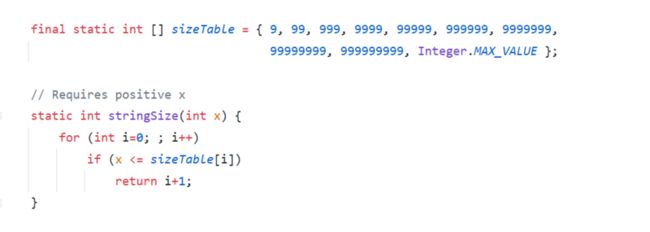上次我们已经对String类源码做了一个简单的总结,感兴趣的小伙伴可以去看一下啃碎JDK源码(一):String,今天来看看Java的Integer包装类。
先来看看Integer实现了哪些接口
public final class Integer extends Number implements Comparable { 可以看到Integer用final修饰,代表不可被继承,继承Number类实现Comparable接口。
private final int value;
public static final int MIN_VALUE = 0x80000000;//最大值
public static final int MAX_VALUE = 0x7fffffff;//最小值
public static final Class TYPE = (Class) Class.getPrimitiveClass("int"); 可以看出使用了int类型的value来存储值,并且定义了Integer的最大值为2^31-1,最小值为-2^31。Integer的基本数据类型为int。
先来看一下Integer的两个构造函数:
public Integer(int value) {
this.value = value;
}
public Integer(String s) throws NumberFormatException {
this.value = parseInt(s, 10);
}那么这个parseInt方法是干啥用的呢?
方法parseInt(String s,int radix)的目的是输出一个十进制数。
比如:parseInt(1010,2)
意思就是:输出2进制数1010在十进制下的数。
我们平时用到Integer.parseInt("123");其实默认是调用了int i =Integer.parseInt("123",10);
下面是源码:
public static int parseInt(String s, int radix)
throws NumberFormatException
{
/*
* WARNING: This method may be invoked early during VM initialization
* before IntegerCache is initialized. Care must be taken to not use
* the valueOf method.
*/
if (s == null) {
throw new NumberFormatException("null");
}
//判断基数是否在 2~36之间
if (radix < Character.MIN_RADIX) {
throw new NumberFormatException("radix " + radix +
" less than Character.MIN_RADIX");
}
if (radix > Character.MAX_RADIX) {//36
throw new NumberFormatException("radix " + radix +
" greater than Character.MAX_RADIX");
}
int result = 0;
boolean negative = false;//是否为负数,默认为false
int i = 0, len = s.length();
int limit = -Integer.MAX_VALUE;
int multmin;
int digit;
if (len > 0) {
char firstChar = s.charAt(0);
if (firstChar < '0') { // Possible leading "+" or "-"
if (firstChar == '-') {//如果是负数,negative赋值为true,限制变为int的最小值
negative = true;
limit = Integer.MIN_VALUE;
} else if (firstChar != '+')
throw NumberFormatException.forInputString(s);
if (len == 1) // Cannot have lone "+" or "-"
throw NumberFormatException.forInputString(s);
i++;
}
/**multmin防止数据溢出
*如果是正数就是-2,147,483,64
*如果是负数就是-2,147,483,64 **/
multmin = limit / radix;
while (i < len) {
// Accumulating negatively avoids surprises near MAX_VALUE
//获取字符转换成对应进制的整数
digit = Character.digit(s.charAt(i++),radix);
if (digit < 0) {
throw NumberFormatException.forInputString(s);
}
if (result < multmin) {
throw NumberFormatException.forInputString(s);
}
result *= radix;
if (result < limit + digit) {
throw NumberFormatException.forInputString(s);
}
result -= digit;
}
} else {
throw NumberFormatException.forInputString(s);
}
return negative ? result : -result;
}valueOf
接下来来看一个比较经典的问题,看下面代码:
Integer a = 100;
Integer b = 100;
Integer c = 200;
Integer d = 200;
System.out.println(a == b);
System.out.println(c == d);你认为这里是四个不同的对象,那么输出应该都是flase?
不,输出结果为:
true
false
通过javap -c/javap -verbose 命令可以查看字节码;红色圈圈里就是我们jdk5之后的基本类型的自动包装的字节码实现,可以看出,此处是调用了Integer.valueOf(..)方法的:说白了就是Integer a = 100 等价于Integer a = Integer.valueOf(100)
JDK1.5之后,java提供了自动装箱和自动拆箱的功能。自动装箱也就是调用了Integer类的一个静态方法valueOf方法,那我们来看看源码是如何实现的:
看看IntegerCache是个什么东西:
可以看到IntegerCache是一个静态内部类,low的值已经写死-128,而high的值由你的虚拟机决定sun.misc.VM.getSavedProperty("java.lang.Integer.IntegerCache.high"),既然是一个参数也就意味着你可以动态设置。然后在循环中将low - high之间数字的装箱后方法cache[]这个Integer类型的数组中。这样就完成了缓存。
因为当我们调用valueOf方法时传入-128到127之间的数字时,Integer会给我们返回同样的对象,记住这一点以后面试的时候也可以和面试官吹吹牛逼了!
接下来我们来看看Integer实现的equals、hashcode和toString等方法:
equals 和 hashcode
public boolean equals(Object obj) {
if (obj instanceof Integer) {
return value == ((Integer)obj).intValue();
}
return false;
}可以看到它会先判断类型是否符合,然后进行拆箱比较操作。
看下hashcode方法:
@Override
public int hashCode() {
return Integer.hashCode(value);
}
public static int hashCode(int value) {
return value;
}可以看到hashcode直接返回本身的int值。
toString
Integer的toString方法 是我认为一个比较有趣的地方:
看下toString(int i)源码:
在上面用到了stringSize方法,就是求这个Integer数的长度,我们来看看他是如何实现的:
可以看到这段代码在计算Integer数长度时,构建了一个一维数组,然后拿x与数组每个值进行比较。
还有一个getChars方法是获取数值对应的字符串,其中有两个地方使用了非常巧妙的方式来进行除法运算和取余运算。在计算机中,a/b 和 a%b相比较位运算,都是比较费时的计算的。下面来看看jdk中是如何优化计算的:
static void getChars(int i, int index, char[] buf) {
int q, r;
int charPos = index;
char sign = 0;
if (i < 0) {
sign = '-';
i = -i;
}
// Generate two digits per iteration
while (i >= 65536) {
q = i / 100;
// really: r = i - (q * 100);
r = i - ((q << 6) + (q << 5) + (q << 2));
i = q;
buf [--charPos] = DigitOnes[r];
buf [--charPos] = DigitTens[r];
}
// Fall thru to fast mode for smaller numbers
// assert(i <= 65536, i);
for (;;) {
q = (i * 52429) >>> (16+3);
r = i - ((q << 3) + (q << 1)); // r = i-(q*10) ...
buf [--charPos] = digits [r];
i = q;
if (i == 0) break;
}
if (sign != 0) {
buf [--charPos] = sign;
}
}其中有一行代码:
q = (i * 52429) >>> (16+3);上面这行公式约等于 q * 0.1,也就是说使用乘法计算比使用除法高效。
思路是这样:
当 i >= 65536时,是每两位取出数字,i /= 100,例如 i = 567235474,
(1)先取最后两位 7 和 4 放入buf数组中,i = 5672354,buf = { , , , , , , , '7', '4'};
(2)再取最后两位 5 和 4 放入buf数组中,i = 56723,buf = { , , , , , '5', '4', '7', '4'};
当 i < 65536 时,跳出循环,采用每一次取出一位数字,也就是 i /= 10
(3)取最后一位 3 放入buf数组中,i = 5672,buf = { , , , , '3', '5', '4', '7', '4'};
(4)取最后一位 2 放入buf数组中,i = 567,buf = { , , , '2', '3', '5', '4', '7', '4'};
(5)取最后一位 7 放入buf数组中,i = 56,buf = { , , '7', '2', '3', '5', '4', '7', '4'};
(6)取最后一位 6 放入buf数组中,i = 5,buf = { , '6', '7', '2', '3', '5', '4', '7', '4'};
(7)取最后一位 5 放入buf数组中,i = 0,buf = { '5', '6', '7', '2', '3', '5', '4', '7', '4'},结束。
总结
关于Integer类暂时介绍到这里,有关其它的包装类Long等源码部分也是类似的,后续就不再介绍,有兴趣的小伙伴可以去研究一下。
![]()






